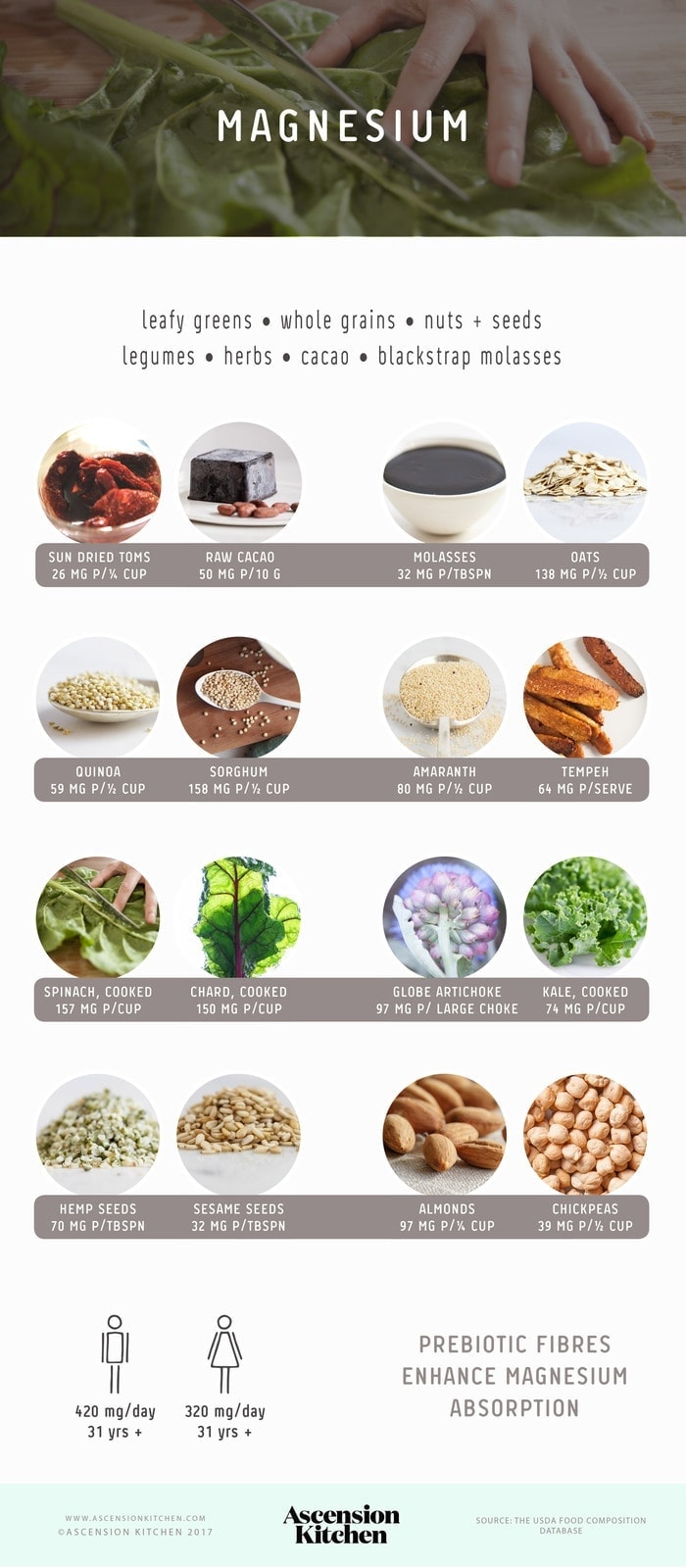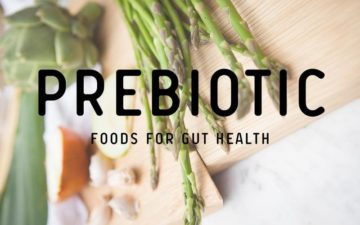
Marvellous magnesium – so critical to the running of our bodies (it is required for over 300 biochemical reactions), it plays a role in supporting healthy cardiovascular function, nerve and muscle relaxation, blood sugar balance, bone health and production of energy.
This post will focus on how to get enough of this important mineral in the diet; what foods provide the best source, what a magnesium-rich diet might look like, and what inhibits and enhances magnesium absorption.
[bctt tweet="Are you getting enough magnesium? Top food sources + a magnesium rich meal plan here." username="laurenglucina"]
How much do we need?
400 mg/day for adult men (19-30 years)
420 mg/day for adult men (31 years +)
310 mg/day for adult women (19-30 years)
320 mg/day for adult women (31 years +)
With increased needs during pregnancy and lactation (view the full RDI chart here) [1].
About magnesium
Magnesium is one of the major minerals, named so as it is present and required in larger amounts in the body. The other major minerals are sodium, chloride, potassium, calcium, phosphorus and sulfate [2]. It is the fourth most abundant cation in the body and the second most abundant intracellular cation [3].
Over 70% of the body’s magnesium is stored in our teeth and bones [4], the rest resides in the muscle and soft tissues, with a small amount (approximately 1%) present in extracellular fluid (interstitial fluid and blood plasma). The little magnesium that is in the blood, is tightly regulated by the body, making it difficult to assess status via a blood test – only a severe deficiency would be able to be detected [5, 6].
Magnesium has a wide and varied role in the body, and is responsible for a whopping 300+ biochemical processes.
Some of magnesium’s roles in the body:
- DNA synthesis and degradation
- Amino acid and protein synthesis
- ATP production (cellular energy production)
- Supports a healthy stress response
- Supports healthy blood pressure and general cardiovascular health
- Required for nerve conduction
- Required for nerve and muscle relaxation
- Blood sugar regulation (modulates the cellular uptake of glucose via insulin)
- Essential for mineralisation of bones and teeth
- Plays a key role in a healthy immune response
[3, 5, 7-10]
Signs of deficiency
Common signs of a magnesium deficiency include;
- Muscle weakness, spasms and cramps, twitchy eyes
- Fatigue and lethargy
- Poor memory, decreased attention span and brain fog
- Anxiety & depression
- Irritability
- Reduced appetite, nausea
- Insomnia
- Hypothalamic-pituitary-adrenal axis dysregulation (adrenal fatigue)
- Hypertension, irregular heartbeat
[5, 11].
Chronic stress can cause a magnesium depletion [3] as can chronic disease – particularly in those where absorption is compromised (such as Celiac’s disease and inflammatory bowel disease). The various dietary inhibitors of magnesium are to be discussed shortly.
Top food sources of magnesium
The best sources of magnesium come from plant foods! In fact, vegetarians, but particularly vegans, have higher magnesium intakes than meat eaters due to a large consumption of whole grains, legumes, nuts and seeds, and green leafy vegetables [12].

Top Food Sources of Magnesium:
This table is best viewed on desktop rather than mobile.
|
Food |
Magnesium |
Magnesium |
% RDI Men |
% RDI Women |
|
VEGETABLES |
||||
|
Sun dried tomatoes |
194mg |
¼ cup = 26mg |
6% |
8% |
|
Shiitake mushrooms |
132mg |
4 mushrooms = 20mg |
5% |
6% |
|
Spinach, boiled |
87mg |
1 cup = 157mg |
37% |
49% |
|
Swiss chard, boiled |
86mg |
1 cup = 150mg |
36% |
47% |
|
Swiss chard, raw |
81mg |
1 cup = 29mg |
7% |
9% |
|
Spinach, raw |
79mg |
1 cup = 24mg |
6% |
8% |
|
Beet greens, raw |
70mg |
1 cup = 27mg |
6% |
8% |
|
Beet greens, boiled |
68mg |
1 cup = 98mg |
23% |
31% |
|
Artichokes, globe |
60mg |
1 large artichoke = 97mg |
23% |
30% |
|
Kale, boiled |
57mg |
1 cup, chopped = 74mg |
18% |
23% |
|
Amaranth leaves, raw |
55mg |
1 cup = 15mg |
4% |
5% |
|
Amaranth leaves, boiled |
55mg |
1 cup = 73mg |
17% |
23% |
|
Parsley, fresh |
50mg |
1 cup, chopped = 30mg |
7% |
9% |
|
Rocket (Arugula) |
47mg |
1 cup = 9mg |
2% |
3% |
|
Acorn squash, baked |
43mg |
1 cup, cubed = 88mg |
21% |
28% |
|
Edamame, frozen, prepared |
64mg |
½ cup = 50mg |
12% |
16% |
|
Watercress, raw |
38mg |
1 cup = 19mg |
5% |
6% |
|
Dandelion greens, raw |
36mg |
1 cup, chopped = 20mg |
5% |
6% |
|
WHOLE GRAINS |
||||
|
Oats |
177mg |
½ cup = 138mg |
33% |
43% |
|
Sorghum, gain |
165mg |
½ cup = 158mg |
38% |
49% |
|
Amaranth, grain, cooked |
65mg |
½ cup = 80mg |
19% |
25% |
|
Quinoa, grain, cooked |
64mg |
½ cup = 59mg |
14% |
18% |
|
Brown rice, whole, cooked |
44mg |
½ cup = 43mg |
10% |
13% |
|
Millet, grain, cooked |
44mg |
½ cup = 38mg |
9% |
12% |
|
NUTS & SEEDS |
||||
|
Hemp seeds, hulled |
700mg |
1 tablespoon = 70mg |
17% |
22% |
|
Pumpkin seeds |
592mg |
2 tablespoons = 95mg |
23% |
30% |
|
Flaxseeds |
392mg |
1 tablespoon, whole = 40mg |
10% |
13% |
|
Brazil nuts |
376mg |
¼ cup, whole = 125mg |
30% |
39% |
|
Sesame seeds |
351mg |
1 tablespoon = 32mg |
8% |
10% |
|
Chia seeds |
333mg |
1 tablespoon, whole = 40mg |
10% |
13% |
|
Almonds |
270mg |
¼ cup, whole = 97mg |
23% |
30% |
|
Cashews (roasted) |
260mg |
¼ cup, whole = 89mg |
21% |
28% |
|
LEGUMES |
||||
|
Lima beans, cooked |
74mg |
½ cup = 63mg |
15% |
20% |
|
Black beans, cooked |
70mg |
½ cup = 60mg |
14% |
19% |
|
Red lentils |
60mg |
½ cup = 58mg |
14% |
18% |
|
Chickpeas, cooked |
48mg |
½ cup = 39mg |
9% |
12% |
|
Tempeh, cooked |
77mg |
83g serve (about 1/3 of a regular 250g pack) = 64mg |
15% |
20% |
|
ANIMAL PROTEINS |
||||
|
Dairy milk, full fat |
10mg |
1 cup = 24mg |
6% |
8% |
|
Egg, hard boiled |
10mg |
1 egg = 5mg |
1% |
2% |
|
Salmon, Alaskan, cooked |
37mg |
1 fillet (154g) = 57mg |
14% |
18% |
|
OTHER |
||||
|
Raw cacao powder (Ceres Organics brand) |
500mg |
10g = 50mg |
12% |
16% |
|
Spirulina powder |
195mg |
1 teaspoon = 4.7mg |
1% |
2% |
|
Blackstrap molasses |
145mg |
1 tablespoon = 32mg |
8% |
10% |
|
Avocado |
29mg |
½ an avocado = 20mg |
5% |
6% |
|
Bananas |
27mg |
1 medium banana = 32mg |
8% |
10% |
|
Coconut milk, canned |
46mg |
½ cup = 52mg |
12% |
16% |
Source: The USDA Food Composition Database.
A person in good health will typically only absorb 30-60% of dietary magnesium via the intestines. When intake is low, this may increase to 60-75% [5, 6].
Magnesium in the diet may look something like this:
Breakfast:
½ cup oats; 138mg
1 tablespoon hemp seeds; 70mg
Snack:
¼ cup almonds; 97mg
Lunch:
1 cup rocket; 9mg
½ cup chickpeas; 39mg
½ avocado; 20mg
2 tablespoons sun dried tomatoes; 13mg
Snack:
1 banana; 32mg
Dinner:
1 serve (83g) of tempeh; 64mg
½ cup acorn squash; 44mg
1 cup cooked spinach; 157mg
1 tablespoon pumpkin seeds; 47.5mg
Total: 730.5mg
RDI for adults 31 years + : 420mg (men); 320mg (women)
Remember: typical absorption rate is anywhere from 30-60%. 730.5mg adjusted for an absorption rate of 30% is 511.35mg, but is only 292.2mg at a 60% absorption rate.
This seems achievable, right?
Yet – according to the Australian Bureau of Statistics (and the 2011-2012 Australian Health Survey), one in three people over the age of two did not meet their magnesium requirements, and a whopping 72% of females in the 14-18 year age group had inadequate intakes. This figure is slightly better for adult women (19-30 years) at just over 37% [13].
We are not eating enough plants!
And this has now been shown, clear as day, in the results of the 2014-15 National Health Survey – 93% of adults are not meeting daily requirements for vegetables, and only half are consuming enough fruit! [14].
A reminder; government guidelines are currently based on ‘5+ a day’ – at least 2 servings of fruit and 3 of vegetables, every day. A serving of vegetables is half a cup, cooked, or a whole cup of salad greens. A serving of fruit is one medium piece.
These guidelines may even need revising – as a recent (2017) meta-analysis of studies suggest 800g (equivalent to 10 servings) of fresh fruit and vege a day is actually optimal when it comes to preventing disease and all-cause mortality [15].
So, listen to your mum, eat your greens! And for goodness sakes, governments around the world, find a way to make fresh produce more affordable to all!

Is magnesium lost in cooking?
Magnesium, like other minerals, is not sensitive to heat. Some loss can occur due to leaching into water when boiling or steaming.
Processed foods are a poor source of magnesium
Food processing essentially deconstructs a whole food in the name of making it more shelf stable, whilst improving organoleptic properties, and even to yield end products that are desirable for industry.
Our richest sources of magnesium are coming from whole grains, legumes, nuts and seeds, and leafy greens. Aside from the greens, all are commonly subjected to processing steps such as dehulling, milling, refining, polishing and roasting. Unfortunately, this results in a significant loss in mineral content, as most of the plant’s nutrients are concentrated in the outer part of the seed or grain. The milling of wheat can reduce magnesium content by 75% or more [6].
Enhancers of magnesium absorption
- Fermentable carbohydrates such as resistant starch, inulin and fructo-oligosachharides (the fermentation of these prebiotic fibres in the large colon can promote the absorption of minerals) [16-17]
- Vitamin D [6, 18]
Inhibitors of magnesium absorption
- Foods high in phytates such as nuts, seeds, legumes, whole grains – but to a smaller extent than other minerals such as iron and zinc [6]
- Excess saturated fat and excessive unabsorbed fatty acids (these can bind to magnesium and form soaps that are then eliminated via a bowel motion), however unabsorbed fatty acids are typically seen with conditions that cause steatorrhoea such as inflammatory bowel disease and celiac disease [6, 19]
- Other minerals: for example, a high phosphorus intake impairs absorption as it binds to magnesium in the gastrointestinal tract (phosphorus rich foods include meats, poultry, eggs, fish, nuts and soy. It is also found in large amounts in soft drinks. High soft drink consumption is also a major contributor to poor bone mineral density, as it impairs absorption of both magnesium and calcium [9])
Magnesium excretion
Magnesium is also excreted via the kidneys, to help maintain homeostasis. Calcium competes with magnesium for renal reabsorption, so excess calcium can affect magnesium status. Alcohol, caffeine, soft drinks, protein and diuretics also increase excretion [6, 19].
Summary
Magnesium is certainly abundant in plant-foods – concentrated in leafy greens, whole grains, nuts and seeds. A worryingly large proportion of Aussie adults are not meeting their daily magnesium requirements, which highlights the real need to include more plant-based whole foods in the diet. A healthy adult will typically only absorb 30-60% of dietary magnesium. Magnesium loss occurs to some extent in cooking, and to a large extent in food processing. Phytates and excess saturated fats inhibit magnesium absorption, whilst prebiotic fibres (such as fructo-oligosacchrides) promote absorption. Vitamin D may also help promote magnesium uptake. As magnesium is excreted via the kidneys, substances that have a diuretic effect (such as alcohol and caffeine) will thus contribute to magnesium loss.
References:
-
NUTRIENT REFERENCE VALUES FOR AUSTRALIA AND NEW ZEALAND. (2014). RETRIEVED FROM https://www.nrv.gov.au/nutrients/magnesium
-
Whitney, E., Rolfes, S., Crowe, T., Cameron-Smith, D., Walsh, A. (2014). Understanding nutrition. Australia and New Zealand edition (2nd ed.). Melbourne, Victoria: Cengage Learning
-
Cuciureanu, M.D., & Vink, R. (2011). Magnesium and stress. In R. Vink & M. Nechifor (Eds). Magnesium in the central nervous system (pp 251-268). University of Adelaide Press
-
Osiecki, H. (2010). The nutrient bible (9th). QLD, Australia: Bio Concepts Publishing
-
Braun, L, & Cohen, M. (2015). Herbs & natural supplements. An evidence-based guide (4th ed., Vol. 2). Sydney, Australia: Churchill Livingstone
-
Gropper, S.S., & Smith, J.L. (2013). Advanced nutrition and human metabolism (6th). Belmont, CA: Wadsworth
-
Kass, L., Weekes, J., & Carpenter, L. (2012). Effect of magnesium supplementation on blood pressure: a meta-analysis. European Journal of Clinical Nutrition,66(4), 411-8.
-
Barbagallo, M., Dominguez, L.J., Galioto, A., Ferlisi, A., Cani, C., Malfa, L., … & Paolisso, G. (2003). Role of magnesium in insulin action, diabetes and cardio-metabolic syndrome X. Molecular Aspects of Medicine, 24(1-3), 39-52.
-
Hudson, T. (2013). Osteoporosis. In J.E. Pizzorno & M.T. Murray (Eds). Textbook of Natural Medicine (4th pp. 1662-1677). St Louis, MO: Elsevier Churchill Livingstone
-
Tam, M., Gomez, S., Gonzalez-Gross, M., & Marcos, A. (2003). Possible roles of magnesium on the immune system. European Journal of Clinical Nutrition, 57, 1193-1197.
-
Sartori, S.S., Whittle, N., Hetzenauer, A., & Singewald, N. (2012). Magnesium deficiency induces anxiety and HPA axis dysregulation: Modulation by therapeutic drug treatment. Neuropharmocology, 62(1), 304-312.
-
DAVEY, G.K., SPENCER, E.A., APPLEBY, P.N., ALLEN, N.E., KNOX, K.H., & KEY, T.J. (2003). EPIC-OXFORD: LIFESTYLE CHARACTERISTICS AND NUTRIENT INTAKES IN A COHORT OF 33 883 MEAT-EATERS AND 31 546 NON MEAT-EATERS IN THE UK.Public Health Nutrition, 6(3), 259-268.
-
Australian Bureau of Statistics. (2015). 4364.0.55.008 - Australian Health Survey: Usual Nutrient Intakes, 2011-12. Retrieved from http://www.abs.gov.au/ausstats/[email protected]/Lookup/by%20Subject/4364.0.55.008~2011-12~Main%20Features~Magnesium~406
-
Australian Bureau of Statistics. (2015). Daily intake of fruits and vegetables. Retrieved from http://www.abs.gov.au/ausstats/[email protected]/Lookup/by%20Subject/4364.0.55.001~2014-15~Main%20Features~Daily%20intake%20of%20fruit%20and%20vegetables~28
-
Aune, D., Giovannucci, E., Boffetta, P., Fadnes, L.T., Keum, N., Norat, T., … & Tonstad, S. (2017). Fruit and vegetable intake and the risk of cardiovascular disease, total cancer and all-cause mortality–a systematic review and dose-response meta-analysis of prospective studies. International Journal of Epidemiology.
-
Coudray, C., Demigné, C., & Rayssiguier, Y. (2003). Effects of dietary fibres on magnesium absorption in animals and humans. The Journal of Nutrition, 133(1), 1-4.
-
Van den Heuvel, E.G.H.M., Muijs, T., Brouns, F., & Hendriks, H.F.J. (2009). Short-chain fructo-oligosaccharides improve magnesium absorption in adolescent girls with a low calcium intake. Nutrition Research, 29, 229-237.
-
Johnson, J. (2001). The multifaceted and widespread pathology of magnesium deficiency. Medical Hypotheses, 56(2), 163-170.
-
Swaminathan, R. (2003). Magnesium metabolism and its disorders. The Clinical Biochemist Reviews, 24(2), 47-66. Retrieved from https://www.ncbi.nlm.nih.gov/pmc/articles/PMC1855626/





Ask me anything